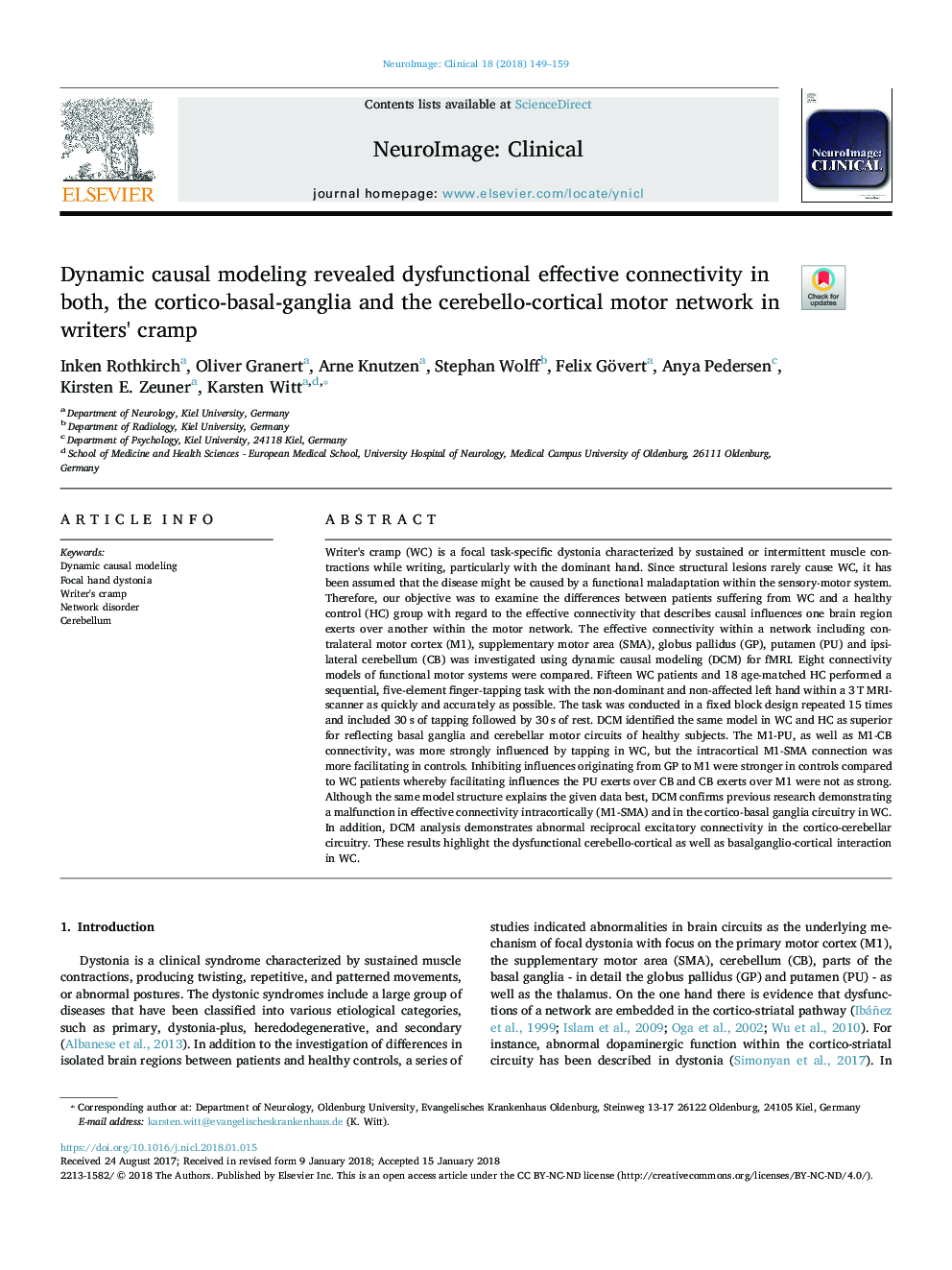| کد مقاله | کد نشریه | سال انتشار | مقاله انگلیسی | نسخه تمام متن |
|---|---|---|---|---|
| 8687738 | 1580949 | 2018 | 11 صفحه PDF | دانلود رایگان |
عنوان انگلیسی مقاله ISI
Dynamic causal modeling revealed dysfunctional effective connectivity in both, the cortico-basal-ganglia and the cerebello-cortical motor network in writers' cramp
ترجمه فارسی عنوان
مدل سازی علت دینامیکی ارتباطات مؤثر ناگوار را در هر دو حالت، کورتیکو-بازال-گانگلیا و شبکه موتور مخروطی در اختلالات نوشتار نشان داد
دانلود مقاله + سفارش ترجمه
دانلود مقاله ISI انگلیسی
رایگان برای ایرانیان
کلمات کلیدی
موضوعات مرتبط
علوم زیستی و بیوفناوری
علم عصب شناسی
روانپزشکی بیولوژیکی
چکیده انگلیسی
Writer's cramp (WC) is a focal task-specific dystonia characterized by sustained or intermittent muscle contractions while writing, particularly with the dominant hand. Since structural lesions rarely cause WC, it has been assumed that the disease might be caused by a functional maladaptation within the sensory-motor system. Therefore, our objective was to examine the differences between patients suffering from WC and a healthy control (HC) group with regard to the effective connectivity that describes causal influences one brain region exerts over another within the motor network. The effective connectivity within a network including contralateral motor cortex (M1), supplementary motor area (SMA), globus pallidus (GP), putamen (PU) and ipsilateral cerebellum (CB) was investigated using dynamic causal modeling (DCM) for fMRI. Eight connectivity models of functional motor systems were compared. Fifteen WC patients and 18 age-matched HC performed a sequential, five-element finger-tapping task with the non-dominant and non-affected left hand within a 3â¯T MRI-scanner as quickly and accurately as possible. The task was conducted in a fixed block design repeated 15 times and included 30â¯s of tapping followed by 30â¯s of rest. DCM identified the same model in WC and HC as superior for reflecting basal ganglia and cerebellar motor circuits of healthy subjects. The M1-PU, as well as M1-CB connectivity, was more strongly influenced by tapping in WC, but the intracortical M1-SMA connection was more facilitating in controls. Inhibiting influences originating from GP to M1 were stronger in controls compared to WC patients whereby facilitating influences the PU exerts over CB and CB exerts over M1 were not as strong. Although the same model structure explains the given data best, DCM confirms previous research demonstrating a malfunction in effective connectivity intracortically (M1-SMA) and in the cortico-basal ganglia circuitry in WC. In addition, DCM analysis demonstrates abnormal reciprocal excitatory connectivity in the cortico-cerebellar circuitry. These results highlight the dysfunctional cerebello-cortical as well as basalganglio-cortical interaction in WC.
ناشر
Database: Elsevier - ScienceDirect (ساینس دایرکت)
Journal: NeuroImage: Clinical - Volume 18, 2018, Pages 149-159
Journal: NeuroImage: Clinical - Volume 18, 2018, Pages 149-159
نویسندگان
Inken Rothkirch, Oliver Granert, Arne Knutzen, Stephan Wolff, Felix Gövert, Anya Pedersen, Kirsten E. Zeuner, Karsten Witt,
